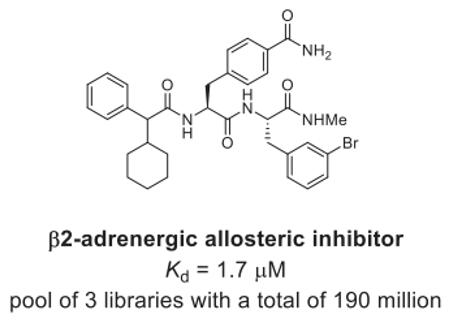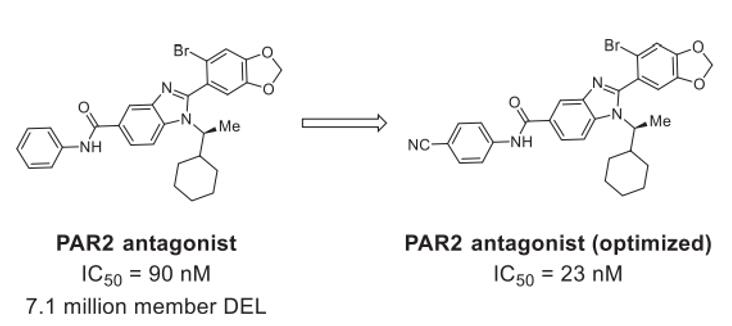G protein-coupled receptors (GPCRs) are integral membrane proteins containing an extracellular amino terminus, seven transmembrane α-helical domains, and an intracellular carboxy terminus. GPCRs recognize a wide variety of signals ranging from photons to ions, proteins, neurotransmitters, and hormones. The physiological importance of GPCRs spans across virtually all organ systems, ranging from the regulation of cardiovascular function to sensory perception and neurotransmission.
In the realm of drug discovery, DNA-encoded libraries (DELs) have emerged as a revolutionary tool, offering unprecedented opportunities for the identification of novel bioactive compounds. Specifically, in the domain of G protein-coupled receptors (GPCRs), DELs have garnered significant attention due to their ability to expedite the screening process and facilitate the discovery of ligands with high affinity and selectivity.
DELs Selection Method for GPCR Ligands
A variety of DELs selection methods are available to enable GPCR ligand discovery, including protein-based, membrane preparation-based, and cell-based methods. Each approach offers unique advantages in GPCR ligand discovery.
Protein-based DELs selection
Protein-based DELs selection involves the screening of compounds against purified, solubilized, and tagged GPCR proteins. This approach provides higher target concentrations and the binding process remains a simple environment. If stable proteins are available, protein-based selection offers a rapid option for GPCR ligand discovery.
Membrane preparation-based DELs selection
Membrane preparation-based DELs selection entails the screening of compounds against membrane fractions containing GPCR targets in their native lipid bilayer environment. This method maintains the conformation of GPCRs in the membrane environment, can provide higher target density through immobilization strategies, and saves the work of purifying proteins from the membrane, facilitating the identification of ligands with enhanced affinity and specificity.
Cell-based DELs selection
Cell-based DELs selection utilizes the native cellular environment to screen compounds against GPCR targets expressed on cell surfaces. This approach does not require target protein purification and preserves the physiological context of GPCR signaling, enabling the identification of ligands with optimal pharmacological profiles.
Examples of DELs Screen for GPCRs
Several recent studies have reported the identification of GPCR binders from DELs. Some of the GPCRs that DELs screens against and the identified GPCR ligands are listed below.
Tachykinin receptors
Tachykinins belong to the superfamily of G protein-coupled seven-transmembrane proteins and tachykinin receptors are found in most peripheral tissues and within the central nervous system. By screening DELs directly on cells overexpressing this receptor, several NK3 tachykinin antagonists with nanomolar binding affinities have been identified, the structures of which are shown in Fig. 1 (1-4) [1].
 Fig. 1 NK3 tachykinin antagonists identified from DELs screens [1].
Fig. 1 NK3 tachykinin antagonists identified from DELs screens [1].
β2-adrenergic receptor
The β2-adrenergic receptor (β2-AR) is a member of the large superfamily of seven transmembrane helix GPCRs. By screening DELs against purified and unliganded proteins, allosteric modulators of β2-AR were identified (Fig. 2). The compound identified with the lowest micromolar binding affinity can enhance the orthosteric inverse agonist binding while decreasing orthosteric agonist binding [1].
 Fig. 2 β2-AR allosteric modulators identified from DELs screens [1].
Fig. 2 β2-AR allosteric modulators identified from DELs screens [1].
Protease-activated receptor 2
Protease-activated receptor 2 (PAR2) is also a GPCR activated by proteolytic cleavage of its N-terminal domain. Two thermostabilized mutated PAR2 versions (StaRs) were screened in parallel against 20 DELs in the presence of PAR2 ligands. The screened compound family showed antagonist activity (1), with the most active compound having an IC50 of 90 nM and can be further optimized to 23 nM (2) [1].
 Fig. 3 PAR2 ligands identified from DELs screens [1].
Fig. 3 PAR2 ligands identified from DELs screens [1].
Advantages of DELs for GPCRs

- Native Membrane Environment Screening: DELs technology enables screening compounds directly against GPCR targets in their native membrane environment. By maintaining the receptors' conformational integrity, DELs ensure more physiologically relevant screening conditions, potentially leading to the discovery of ligands with higher biological activity.
- Enhanced Chemical Diversity: DELs offer unparalleled chemical diversity, with libraries containing millions to billions of unique small molecules. This vast molecular repertoire increases the likelihood of identifying novel GPCR binders with diverse chemical scaffolds and pharmacological profiles.
- Cost and Time Efficiency: DELs screening is conducted at significantly reduced costs and timescales compared to traditional methods. The reduced time and cost associated with DELs screening accelerate the pace of GPCR-targeted drug discovery endeavors, making it a more efficient approach for researchers and pharmaceutical companies.
DELs have emerged as powerful tools in GPCR ligand discovery, offering innovative screening strategies and unparalleled advantages. Contact us today to learn more about our services and discover how we can empower your journey towards innovation and success.
Reference
- Madsen, D. et al. An overview of DNA-encoded libraries: A versatile tool for drug discovery. Prog Med Chem. 2020, 59: 181-249.
